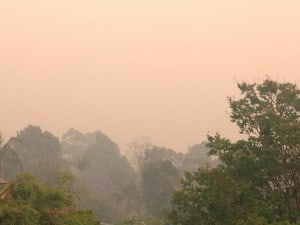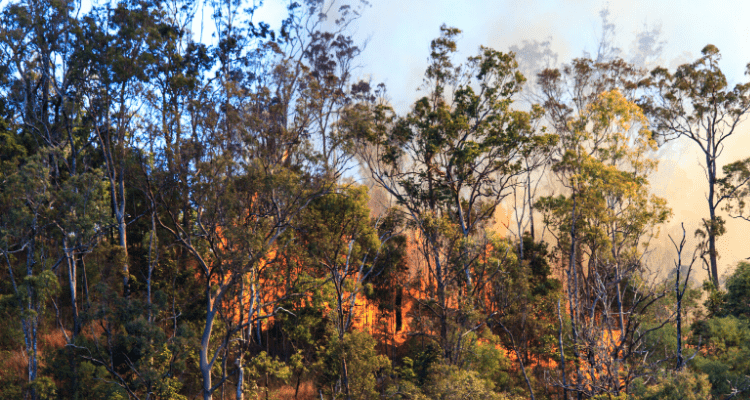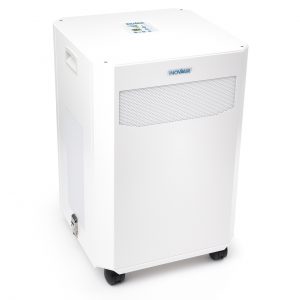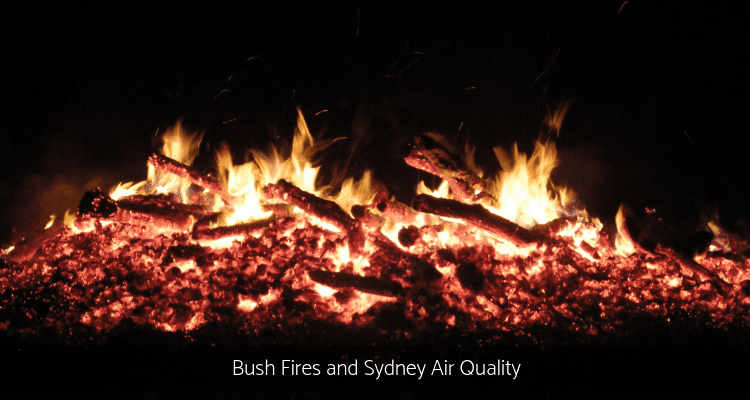
 Today, I read a question on Facebook if anyone knew where on the beaches of Sydney that had no to little smoke. The person had bad asthma and couldn’t get the smoke out of her house.
Today, I read a question on Facebook if anyone knew where on the beaches of Sydney that had no to little smoke. The person had bad asthma and couldn’t get the smoke out of her house.
Bushfires have been burning in the outer Sydney area for the last couple of weeks, casting a pall of smoke and haze over the city, Blue Mountains, Illawarra and CentralCoast regions. The hazey conditions, blanketed by cloud, will continue over the next few days at least or until the fires subside or weather conditions change.
Visibility across the Sydney basin was down to a few kilometres. Typically, Sydney’s air quality is good to very good according to monitoring by the NSW Office of Environment and Heritage air quality data index here http://www.environment.nsw.gov.au/aqms/aqitable.htm The index updates every hour with readings 15 to 50 times higher above normal levels, considered to be “poor” to “very poor” air quality.

That event was last year in the summer of 2018 – 19.
This year, summer of 2019 – 20 bushfires affected regions in NSW located on the north and mid north coasts, Hawkesbury and Blue Mountains, southern highlands and south coast, Riverina and Snowy Mountains, and some suburbs of metropolitan Sydney, in NSW alone. Other states experienced multiple series of bushfires sending a shrouding haze over Adelaide and Sydney and onto New Zealand across the ditch.
Bushfires can result in a large amount of smoke particles and pollens easily transported to any part of the state by the winds. Increased particulate matter in the air irritate airways and shown to have adverse health effects on cardio-respiratory health. The particles are graded at PM10µm and PM2.5µm. The larger particles are usually trapped in the nose and throat and swallowed. The smaller particles are unpleasant, unhealthy and have nowhere else to go except your lungs and cause irritation.
Smoke irritation symptoms include acute itchy or burning eyes and throat, runny nose, coughing, shortness of breath, headaches, coughing. Existing illnesses such as asthma, bronchitis, hay fever, allergies and lung conditions can be further aggravated.
Signs and symptoms of smoke exposure
The gases and fine particles produced during a bushfire can make existing respiratory diseases worse, according to Department of Health, Western Australia, causing:
- difficulty breathing
- coughing
- chest tightness.
People with heart disease may experience chest pain, palpitations, difficulty breathing, fatigue. When smoke levels are high, even healthy people may experience some of these symptoms.
Most people recover quickly from smoke exposure, particularly if they are moved to fresh air, and do not suffer long-term health effects.
Children, the elderly and those with respiratory conditions are most vulnerable and need to take extra precautions. Those people who are otherwise healthy can be adversely affected by high bush fire pollution levels as well and are encouraged to avoid running or exercising outside.
NSW Health advises those at risk to bush fire smoke to stay inside and keep doors and windows closed, remain in an air conditioned building if possible, drink plenty of water, stay cool, don’t exercise outside and asthma sufferers should follow their asthma action plan.
The best treatment is to avoid polluted environments, find cleaner air. Air conditioned rooms provide welcome relief, whether at home or friend’s, in the shopping centres or even in the movie theatre
PRODUCT:
Air Purifier
E20 PLUS includes an additional final stage 6kg carbon filter for applications requiring heavy duty chemical & odour removal. Excellent for removing pollution from main roads, smoke and mycotoxins produced by mould spores.

Considered hiring an air purifier? Breathe easier, sleep soundly and feel better by improving your indoor air quality. Round the clock protection effectively removes airborne pollutants and particulate matter when you need it most.
For more info about hazardous Sydney air quality or air purifier hire please contact us here.
Picture taken in Terrey Hills by RFS NSW
Towards healthier living Carol Parr ♥
2nd Updated: January 20th, 2020. 1st Updated: February 23rd, 2019.
As Building Biologists, we have acquired knowledge of adverse health effects and recommend effective strategies to reduce occupants’ exposure by eliminating and controlling as many sources of pollutants in order to create healthy indoor living environments that are as exposure-free and natural as practically possible.
References:
“How bad is bushfire smoke for health?”. BBC News. 5 December 2019. Retrieved 20th January 2020.
Government of Western Australian Health Department. 2020. Smoke Hazard from Bush Fires. [ONLINE] Available at: https://healthywa.wa.gov.au/Articles/S_T/Smoke-hazard-from-bushfires [Assessed 20 January, 2020]
Environment Protection Agency Victoria. 2017. Effects of Smoke. [ONLINE] Available at: https://www.epa.vic.gov.au/your-environment/air/smoke/effects-of-smoke. [Accessed 30 November 2018].
Queensland Government. 2018. Bushfire Smoke and Your Health. [ONLINE] Available at: https://www.qld.gov.au/health/staying-healthy/environmental/after-a-disaster/bushfires/bushfire-smoke-and-your-health. [Accessed 30 November 2018].
Queensland Government. nd. Smoke Hazards from Bushfires. [ONLINE] Available at: https://healthywa.wa.gov.au/Articles/S_T/Smoke-hazard-from-bushfires. [Accessed 30 November 2018].
Author
-
We’re glad you’re here. We’re Carol and Tony, founders of one of the longest running Healthy Home Blogs in the world, Mitey Fresh Australia. We’ve been on this journey for the last 25 years and are passionate about helping families sift through health hazards and triggers like allergens, mould, water damage, chemicals and EMFs, to get clarity about what’s toxic and what’s not so they can create a healthy and happy home for their family they love. Each month, people visit this blog seeking focus on the health and wellbeing of their loved ones, sustainable and effective practice tips and guides, to help create and manage healthier indoor spaces, improve the built environment that is pleasing to the senses and support healthy living and nature, every day. Starting this blog was to help change people’s lives, one family at a time, and we can’t wait to share how its allowed us to stand next to you and show you how interpreting these synergies between buildings and the environment they are built in will impact upon the health and well-being of those who occupy them. Find out more about Healthy Homes and what this blog can do for you!





